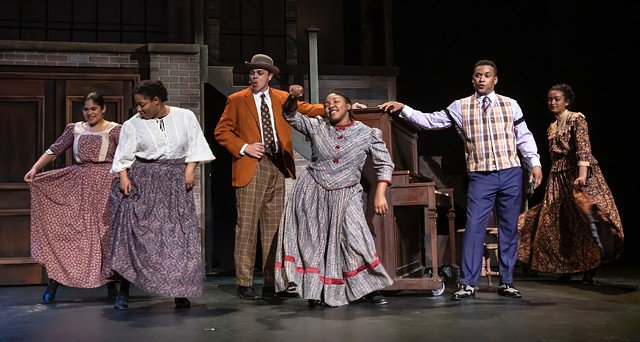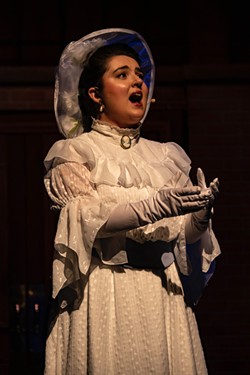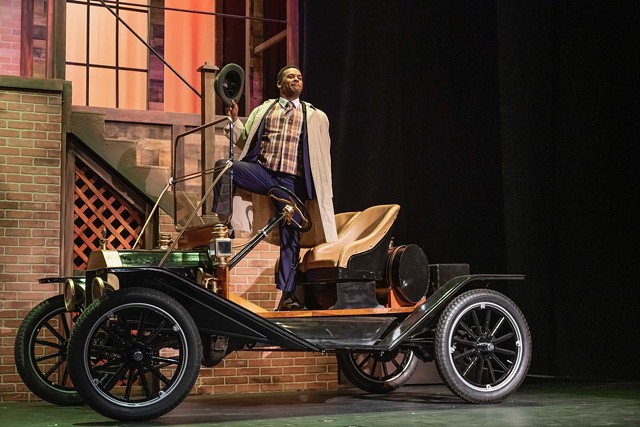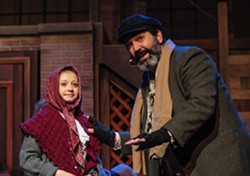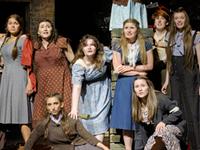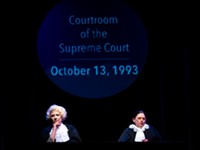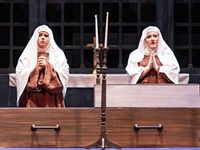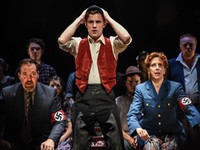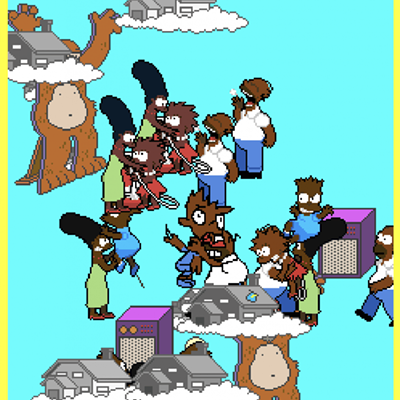[
{
"name": "500x250 Ad",
"insertPoint": "5",
"component": "15667920",
"parentWrapperClass": "",
"requiredCountToDisplay": "1"
}
]
Police brutality, labor strikes, celebrity obsession–the musical “Ragtime” always seems to be relevant. During the JCC CenterStage’s finely staged production, playing through May 21, audience members can decide if that’s a testimony to the musical as a work of art, or a reflection of how little has changed in over 100 years of American history.
The production, directed by Esther Winter, was supposed to be announced in 2020 but was canceled due to the COVID-19 pandemic. Now it’s finally onstage, and it was well worth the wait. Opening night was sold out to an enthusiastic crowd, and an extra performance has already been added on May 21 to accommodate high ticket demand.
“Ragtime” belongs to the same category of ambitious, epic musicals as “Les Misérables,” with its huge cast, sprawling storytelling, and show-stopping ballads. Based on E. L. Doctorow’s 1975 novel, the musical was nominated for 13 Tony Awards when it premiered on Broadway in 1998. Although it lost the coveted Best Musical award to “The Lion King,” it continues to be a crowd favorite, largely due to its iconic score with lyrics by Lynn Ahrens and music by Stephen Flaherty. The score draws influences from Broadway pop, gospel, klezmer, operetta, vaudeville, and of course, ragtime.
The plot weaves together the lives of three families living in New York in 1906. There’s the upper-class white family, anchored by Mother (played by Abby Rice), who experiences independence for the first time when her husband leaves on an expedition to the North Pole. Meanwhile, her Younger Brother (played by Jacob French) searches for meaning in life beyond hedonistic vaudeville entertainment. There’s the successful Harlem pianist Coalhouse Walker Jr. (played by J. Simmons, who also choreographed the fight sequences), who falls in love with Sarah (played by Nelly Bryce) but leaves her to go on tour without knowing she’s pregnant. And then there’s the Jewish immigrant Tateh (played by Danny Hoskins) and his young daughter (played by Quinn Kenyon), arriving on a boat with extreme optimism only to find tenement and work conditions as bad as the ones they left behind in Latvia. These fictional characters’ lives are threaded together with cameos from historical figures, including Harry Houdini, Emma Goldman, and Booker T. Washington.
There’s a lot of characters to keep track of, but from the moment the curtain opens on the two-story brick house set, the audience is clearly in good hands. The first number in “Ragtime” is arguably one of the best opening numbers in musical theater: every character and conflict gets introduced in a compelling and moving way. You forget you’re watching eight minutes of exposition. It’s a treat to see this number staged so proficiently, with a cast of talented performers each perfectly suited to their role. The period costumes, designed by Diane Spacher, immediately suggest a character’s status and personality, from the woolen shawls of the immigrants to Coalhouse’s striking vests. Jack Witmer’s atmospheric lighting design highlights the division between the white, black, and immigrant characters with an ironically patriotic red, white, and blue glow.
Esther Winter’s direction and choreography, which takes inspiration from the original Broadway production, captivates the audience for the full two-and-a-half hours. Winter knows when to play up the showbiz and when to trust individual performers to shine. Some scenes burst with choreography and spectacle, like the dancing ragtime band in “Atlantic City” or the Model T that rolls on stage at the end of “Henry Ford.” Other moments are dialed back, but equally stunning. Bryce creates an entire world of heartbreak singing “Your Daddy’s Son” in front of a closed curtain.
The range of this show is dizzying. There’s delightful comedic moments like “What a Game,” in which Father’s traditional expectations of a baseball game are met with the raucous reality. There’s inspirational power ballads like “Back to Before,” which allows Rice to showcase her soaring voice and controlled vibrato. And then there’s full ensemble numbers like the heart-wrenching “Till We Reach That Day,” featuring an explosive solo by Jyonnah Ware.
There’s so much going on in this show, from its historical references to its interweaving plots, that it would be a miracle if every moment rang true. For those willing to go along with its sometimes outlandish plot points, this show offers an emotional roller coaster.
Tateh’s story is the ultimate American dream fantasy. He starts out as an impoverished, mistreated immigrant who invents the concept of flip books, which somehow launches him on a career as a highly successful movie director. Hoskins highlights Tateh’s early angry bitterness, which softens once he reinvents himself as the Baron Ashkenazy and befriends Mother.
Meanwhile, Coalhouse’s story follows an opposite trajectory. His story starts on a high note, reuniting with Sarah in the gorgeous “New Music” and imagining a better future with her, symbolized by his Model T, with their powerful duet “Wheels of a Dream.” After a horrific incident, Coalhouse’s response to the soul-crushing racism he encounters becomes more extreme. Even when the plot points leading up to the climax are muddled – a result of Terrence McNally’s book, which loses steam and clarity towards the end of the second act – Simmons’s performance is moving. He captures Coalhouse’s transformation from a charismatic performer to a man completely hollowed out by grief. You can see the innocence drain from his eyes.
As American musicals are prone to do, the show tries to wrap everything up with a feel-good ending. The cast does their best to sell the finale – Coalhouse and Sarah grin at each other as they sing a rousing reprise of “Wheels of a Dream,” and it’s delightful to see two endearing child actors (Mason Morrison and Quinn Kenyon) welcome a third (Christopher Cummins) onstage. The musical seems to hope you’ll forget that this supposedly uplifting conclusion for Tateh and Mother comes at the cost of two Black characters being killed by the state. Hopefully, audiences will take a step back from the fine performances, the dazzling costumes and whirlwind of story, and question if this future is really the best version of the American dream.
The production, directed by Esther Winter, was supposed to be announced in 2020 but was canceled due to the COVID-19 pandemic. Now it’s finally onstage, and it was well worth the wait. Opening night was sold out to an enthusiastic crowd, and an extra performance has already been added on May 21 to accommodate high ticket demand.
“Ragtime” belongs to the same category of ambitious, epic musicals as “Les Misérables,” with its huge cast, sprawling storytelling, and show-stopping ballads. Based on E. L. Doctorow’s 1975 novel, the musical was nominated for 13 Tony Awards when it premiered on Broadway in 1998. Although it lost the coveted Best Musical award to “The Lion King,” it continues to be a crowd favorite, largely due to its iconic score with lyrics by Lynn Ahrens and music by Stephen Flaherty. The score draws influences from Broadway pop, gospel, klezmer, operetta, vaudeville, and of course, ragtime.
The plot weaves together the lives of three families living in New York in 1906. There’s the upper-class white family, anchored by Mother (played by Abby Rice), who experiences independence for the first time when her husband leaves on an expedition to the North Pole. Meanwhile, her Younger Brother (played by Jacob French) searches for meaning in life beyond hedonistic vaudeville entertainment. There’s the successful Harlem pianist Coalhouse Walker Jr. (played by J. Simmons, who also choreographed the fight sequences), who falls in love with Sarah (played by Nelly Bryce) but leaves her to go on tour without knowing she’s pregnant. And then there’s the Jewish immigrant Tateh (played by Danny Hoskins) and his young daughter (played by Quinn Kenyon), arriving on a boat with extreme optimism only to find tenement and work conditions as bad as the ones they left behind in Latvia. These fictional characters’ lives are threaded together with cameos from historical figures, including Harry Houdini, Emma Goldman, and Booker T. Washington.
There’s a lot of characters to keep track of, but from the moment the curtain opens on the two-story brick house set, the audience is clearly in good hands. The first number in “Ragtime” is arguably one of the best opening numbers in musical theater: every character and conflict gets introduced in a compelling and moving way. You forget you’re watching eight minutes of exposition. It’s a treat to see this number staged so proficiently, with a cast of talented performers each perfectly suited to their role. The period costumes, designed by Diane Spacher, immediately suggest a character’s status and personality, from the woolen shawls of the immigrants to Coalhouse’s striking vests. Jack Witmer’s atmospheric lighting design highlights the division between the white, black, and immigrant characters with an ironically patriotic red, white, and blue glow.
Esther Winter’s direction and choreography, which takes inspiration from the original Broadway production, captivates the audience for the full two-and-a-half hours. Winter knows when to play up the showbiz and when to trust individual performers to shine. Some scenes burst with choreography and spectacle, like the dancing ragtime band in “Atlantic City” or the Model T that rolls on stage at the end of “Henry Ford.” Other moments are dialed back, but equally stunning. Bryce creates an entire world of heartbreak singing “Your Daddy’s Son” in front of a closed curtain.
The range of this show is dizzying. There’s delightful comedic moments like “What a Game,” in which Father’s traditional expectations of a baseball game are met with the raucous reality. There’s inspirational power ballads like “Back to Before,” which allows Rice to showcase her soaring voice and controlled vibrato. And then there’s full ensemble numbers like the heart-wrenching “Till We Reach That Day,” featuring an explosive solo by Jyonnah Ware.
There’s so much going on in this show, from its historical references to its interweaving plots, that it would be a miracle if every moment rang true. For those willing to go along with its sometimes outlandish plot points, this show offers an emotional roller coaster.
Tateh’s story is the ultimate American dream fantasy. He starts out as an impoverished, mistreated immigrant who invents the concept of flip books, which somehow launches him on a career as a highly successful movie director. Hoskins highlights Tateh’s early angry bitterness, which softens once he reinvents himself as the Baron Ashkenazy and befriends Mother.
Meanwhile, Coalhouse’s story follows an opposite trajectory. His story starts on a high note, reuniting with Sarah in the gorgeous “New Music” and imagining a better future with her, symbolized by his Model T, with their powerful duet “Wheels of a Dream.” After a horrific incident, Coalhouse’s response to the soul-crushing racism he encounters becomes more extreme. Even when the plot points leading up to the climax are muddled – a result of Terrence McNally’s book, which loses steam and clarity towards the end of the second act – Simmons’s performance is moving. He captures Coalhouse’s transformation from a charismatic performer to a man completely hollowed out by grief. You can see the innocence drain from his eyes.
As American musicals are prone to do, the show tries to wrap everything up with a feel-good ending. The cast does their best to sell the finale – Coalhouse and Sarah grin at each other as they sing a rousing reprise of “Wheels of a Dream,” and it’s delightful to see two endearing child actors (Mason Morrison and Quinn Kenyon) welcome a third (Christopher Cummins) onstage. The musical seems to hope you’ll forget that this supposedly uplifting conclusion for Tateh and Mother comes at the cost of two Black characters being killed by the state. Hopefully, audiences will take a step back from the fine performances, the dazzling costumes and whirlwind of story, and question if this future is really the best version of the American dream.
Speaking of...
Latest in Theater
More by Katherine Varga
-
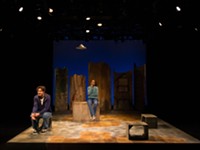
Theatre Review | 'Sanctuary City'
Apr 1, 2024 -
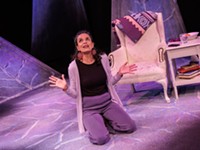
Theatre Review | 'Mala'
Mar 27, 2024 -
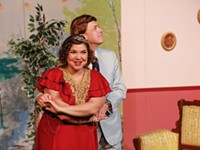
Theatre Review | "The Rivals"
Mar 25, 2024 - More »
